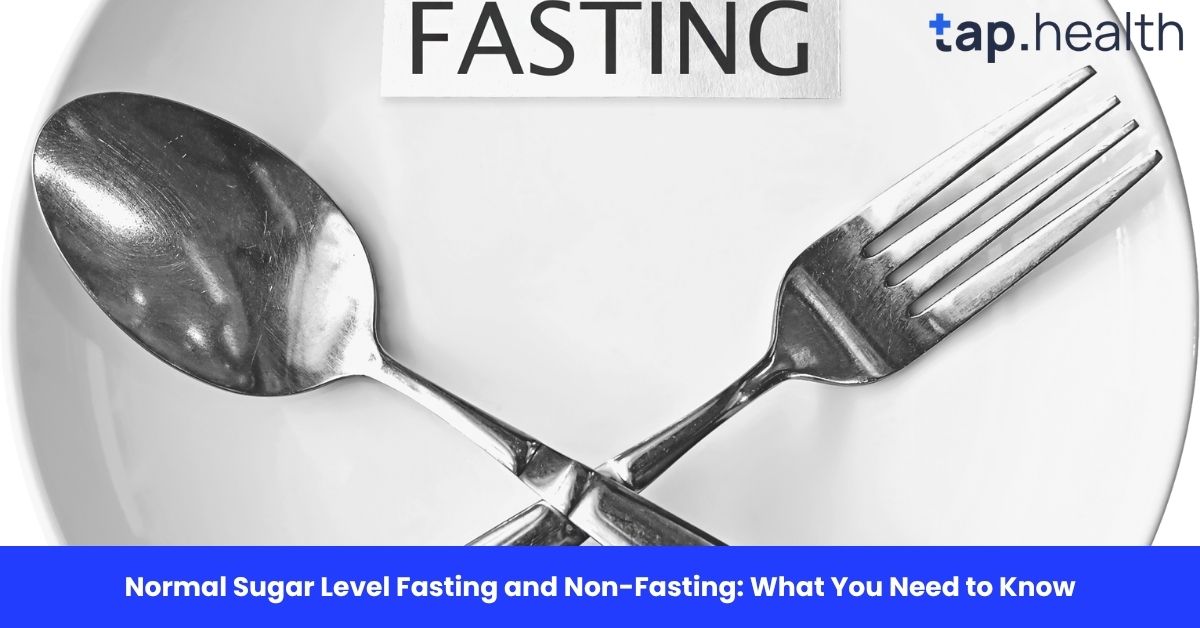Maintaining normal blood sugar levels is crucial for overall health, and understanding what constitutes a normal sugar level in both fasting and non-fasting states is essential. Whether you’re trying to manage your diabetes, prevent it, or just monitor your general health, understanding these numbers can help you make informed decisions about your lifestyle and diet.
In this article, we’ll explore what normal sugar levels are during fasting and non-fasting periods, why they matter, and how you can maintain healthy levels to reduce the risk of chronic conditions like diabetes. We’ll also answer common questions and myths related to blood sugar levels, providing you with a complete guide to better understand the topic.
What is Blood Sugar (Glucose)?
Blood sugar, or glucose, is the sugar found in your blood and is a key source of energy for your body’s cells. The body gets glucose from the foods you eat, especially carbohydrates like rice, bread, and fruits. Insulin, a hormone produced by the pancreas, helps regulate glucose by allowing it to enter the cells for energy. If glucose levels are too high or too low, it can lead to health problems, ranging from fatigue and dizziness to serious conditions like diabetes.
Normal Fasting Blood Sugar Levels
Fasting blood sugar refers to the glucose level in your blood after not eating for at least 8 hours. This is typically tested in the morning, before breakfast, to get an accurate measure of your body’s baseline glucose level without the influence of food.
Ideal Range for Normal Fasting Blood Sugar
A normal fasting blood sugar level is typically between 70–99 mg/dL (milligrams per deciliter). If your fasting blood sugar is consistently within this range, it means your body is effectively processing glucose.
- Less than 100 mg/dL: Normal fasting blood sugar.
- 100–125 mg/dL: This is considered prediabetes, which means your body is beginning to have trouble processing glucose properly. Lifestyle changes like diet and exercise can help reverse this.
- 126 mg/dL or higher: This is indicative of diabetes. If confirmed by repeated testing, it’s essential to consult with your healthcare provider to manage the condition.
Why Fasting Blood Sugar Matters
Fasting blood sugar is an important indicator of your overall health because it measures how well your body handles glucose after a period of rest. Consistently elevated fasting blood sugar can indicate that your body is not producing enough insulin or is not responding to insulin efficiently, both of which are key issues in diabetes.
Normal Non-Fasting Blood Sugar Levels
Non-fasting blood sugar levels are measured at any time of the day, regardless of when you last ate. This test is also known as a random blood glucose test. Unlike the fasting test, this measurement can be taken after eating.
Ideal Range for Normal Non-Fasting Blood Sugar
A normal non-fasting blood sugar level generally falls between 80–140 mg/dL. Here’s how to interpret your results:
- Less than 140 mg/dL: Normal non-fasting blood sugar levels.
- 140–199 mg/dL: This is considered prediabetes, suggesting your body is not processing glucose efficiently.
- 200 mg/dL or higher: This may indicate diabetes, especially if the high levels are confirmed in multiple tests. Immediate consultation with a healthcare provider is recommended.
Why Non-Fasting Blood Sugar Levels Matter
Non-fasting blood sugar levels are important for understanding how your body responds to food and drinks throughout the day. A higher than normal non-fasting blood sugar level could suggest that your insulin is not working properly after meals, which is often a precursor to type 2 diabetes.
How to Maintain Healthy Blood Sugar Levels
Maintaining healthy blood sugar levels is important for everyone, especially those at risk of developing diabetes. Here are a few strategies to help keep your blood sugar levels in check:
1. Balanced Diet
Eating a diet rich in whole grains, vegetables, fruits, lean proteins, and healthy fats is essential for maintaining normal blood sugar levels. Foods like oats, brown rice, and legumes help stabilise blood sugar.
2. Exercise Regularly
Physical activity helps the body use insulin more effectively, and it can reduce your blood sugar levels over time. Aim for at least 30 minutes of moderate exercise most days of the week.
3. Monitor Your Blood Sugar
If you’re at risk of diabetes or have been diagnosed with it, regular blood sugar testing is essential. This will help you understand how your lifestyle choices impact your glucose levels and allow you to take action before problems arise.
4. Manage Stress
Chronic stress can raise blood sugar levels due to the release of hormones like cortisol. Incorporating stress management techniques like deep breathing, yoga, or meditation can help regulate blood sugar.
5. Get Enough Sleep
Sleep plays a key role in maintaining healthy blood sugar levels. Lack of sleep can interfere with the body’s ability to process glucose and insulin. Aim for 7–9 hours of sleep each night.
Myths vs. Facts about Blood Sugar Levels
Myth 1: Fasting Blood Sugar Levels Don’t Matter if I’m Not Diabetic
Fact: Even if you are not diabetic, maintaining normal fasting blood sugar levels is important for overall health. Elevated levels can be an early sign of insulin resistance or prediabetes, which can be reversed with lifestyle changes.
Myth 2: Non-Fasting Blood Sugar is Less Important Than Fasting Blood Sugar
Fact: Both fasting and non-fasting blood sugar tests are important for understanding how your body manages glucose. Non-fasting tests help determine how well your body processes glucose after eating, while fasting tests show how well your body handles glucose when it’s not influenced by food intake.
Myth 3: It’s Only Important to Test Blood Sugar if You Have Diabetes
Fact: Even if you don’t have diabetes, knowing your blood sugar levels can help you catch early signs of prediabetes or other health issues, and take preventative measures before more serious conditions develop.
Read this : Is a 105 mg/dL blood sugar level dangerous?
The Link Between Blood Sugar Levels and Diabetes
Uncontrolled blood sugar levels over time can lead to type 2 diabetes. The body becomes less sensitive to insulin or doesn’t produce enough of it, leading to chronically elevated blood sugar levels. Understanding what is considered normal blood sugar, both fasting and non-fasting, can help prevent the onset of diabetes by taking timely actions like improving diet, exercising, and monitoring blood sugar regularly.
Key Takeaways
- Fasting Blood Sugar Levels: Normal levels range from 70–99 mg/dL. Anything above 100 mg/dL could indicate prediabetes or diabetes.
- Non-Fasting Blood Sugar Levels: Normal levels fall between 80–140 mg/dL. Higher levels may indicate prediabetes or diabetes.
- Lifestyle Changes: Eating a balanced diet, exercising regularly, and managing stress can help maintain healthy blood sugar levels.
- Importance of Monitoring: Regular blood sugar testing, both fasting and non-fasting, is crucial for early detection of any abnormalities, especially for those at risk of diabetes.
Frequently Asked Questions (FAQs) on Normal Sugar Level Fasting and Non-Fasting
Q1: What is the normal range for fasting blood sugar levels?
A1: Normal fasting blood sugar levels are between 70–99 mg/dL. Anything above this range may indicate prediabetes or diabetes.
Q2: What is the normal range for non-fasting blood sugar levels?
A2: A normal non-fasting blood sugar level is between 80–140 mg/dL. Higher levels can indicate prediabetes or diabetes.
Q3: Can stress affect blood sugar levels?
A3: Yes, stress can increase blood sugar levels. Stress hormones like cortisol can interfere with insulin and raise glucose levels.
Q4: How can I maintain healthy blood sugar levels?
A4: A healthy diet, regular exercise, stress management, and monitoring blood sugar levels are key to maintaining normal blood sugar.
Q5: Is fasting blood sugar more important than non-fasting blood sugar?
A5: Both fasting and non-fasting blood sugar levels are important. Fasting levels indicate how your body handles glucose after a period of rest, while non-fasting levels show how it processes glucose after meals.
Q6: How often should I check my blood sugar levels?
A6: If you’re at risk for diabetes or have already been diagnosed, check your blood sugar regularly, as advised by your healthcare provider. For healthy individuals, annual testing is often recommended.
Q7: Can I eat before a fasting blood sugar test?
A7: No, you should not eat or drink anything except water for at least 8 hours before a fasting blood sugar test to get accurate results.
Q8: Are there any symptoms of high blood sugar?
A8: Yes, symptoms of high blood sugar may include excessive thirst, frequent urination, fatigue, and blurred vision. If you experience these, it’s important to consult a doctor.



